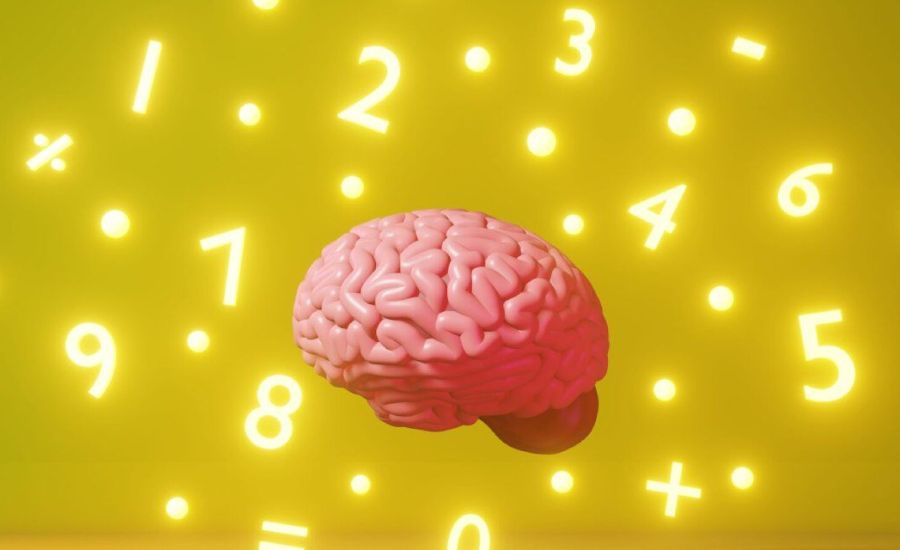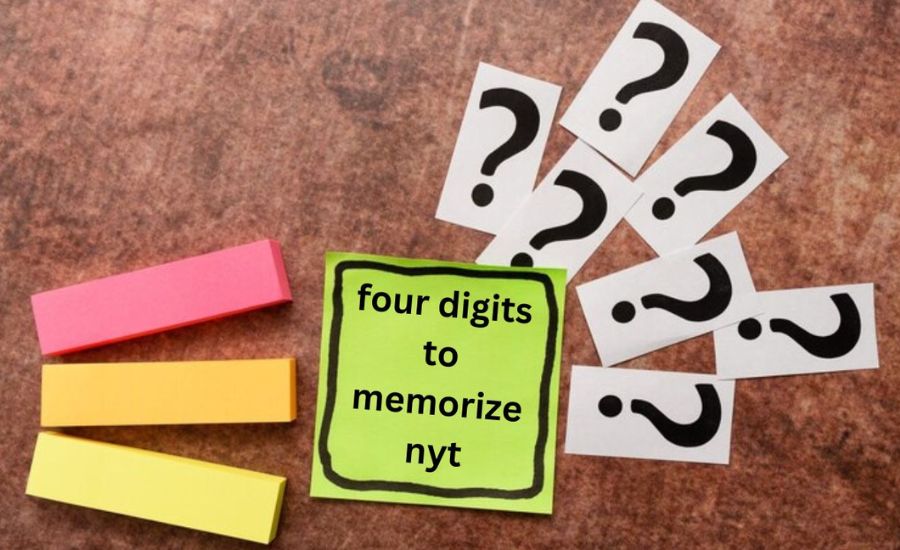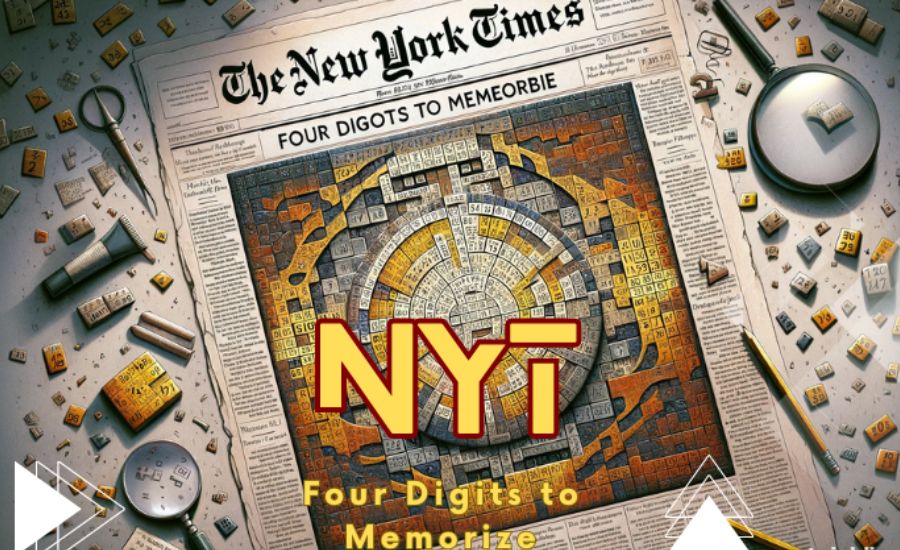In today’s tech-driven world, numbers are everywhere, right? They’re like these intricate little codes that run through everything we do, from our phone digits to our ID numbers. They’re basically the backbone of how we communicate and keep things organized. Being able to remember numbers well is seriously handy, no matter who you are – whether you’re a student, a pro, or just someone who wants to keep their brain sharp. So, let’s dig into this cool memory trick called “Four Digits to Memorize NYT” and see how it could totally up your game when it comes to recalling numbers.
What is Four Digits to Memorize Nyt?

In today’s digital era, our gadgets are like our personal memory assistants, holding onto all sorts of info for us – phone numbers, addresses, you name it. But, there are moments when we can’t just rely on our devices. That’s when having a sharp memory really counts. And that’s where the magic of four-digit sequences comes into play.
The piece called “Four Digits to Memorize NYT” delves into this fascinating memory trick that makes it easier to remember long strings of numbers.
Comprehending the Four Digit Technique
A Synopsis of the History and Its Use
The four-digit memorization trick is all about connecting numbers with real, visual stuff. It leans on methods like the ‘story method’ or ‘link method,’ which have been around since ancient Greek days but have been tweaked for today. Basically, you turn each number into a picture that sticks in your mind, then link those images together in a sequence. It’s like planting the number firmly in your brain for the long haul.
Instances of Number Significance
Think about the number 1492. For lots of folks, that year is instantly linked with Columbus setting sail for the Americas. But with the trick we’re talking about, you can give it even more depth. You connect each digit with a visual image, action, or idea. So, for 1492, you might imagine a boat (for the voyage), a monk (for the new ideas Columbus’s journey sparked), and more. These vivid, creative scenes stick in your mind way better, making your memories stronger and longer-lasting.
The Science Behind Memory
With the benefits of memorizing four numbers now established, let’s explore the fascinating field of memory research.
The human brain is an amazing organ that has enormous storage capacity. However, their memory is also selective.
- Comparing Short-Term and Long-Term Memory: Consider the short-term and long-term memory sections of your brain as two distinct libraries. Information temporarily resides in short-term memory before being discarded or transferred to long-term shelves for safekeeping, similar to the checkout counter at a library.
- Chunking: Ah, the magic trick of memory champs! Chunking is all about breaking big chunks of info into smaller, easier-to-handle pieces. When we chunk info, our brains can gobble it up and store it away more smoothly for later use.
- Repetition: The key to improving memory is repetition. Anything has a greater chance of sticking around in our brains the more we repeat it. So, if you’re serious about nailing those four digits, keep on repeating them!
Importance of Four Digits to Memorize NYT
Memorizing those four-digit sequences isn’t just a little memory game – it’s a big deal for sharpening your brainpower. It’s like a workout for your mind, pushing it to store info in a neat, compact way. And as you practice, your brain gets better at it, building up those neural pathways that make you smarter overall. Plus, once you’ve nailed this skill, you’re set to tackle even fancier memory techniques down the road.
How to Use the Four-Digit Memorization Technique?

Alright, now that we’ve covered why the Four Digits to Memorize Method rocks, let’s dive into how to put it into action. Here are some simple steps that anyone can tackle:
Step 1: Break It Down
Start by slicing that long number sequence into chunks of four digits each. Breaking it up like this makes it way easier to handle and remember.
Step 2: Get Creative
Now, link each set of four digits to a vivid mental picture or story. Make these images funky and unforgettable. If you were given the sequence “1428 7395 6083,” for instance, you may visualize a lion (1428) growling at a bird (7395) relaxing on a fence (6083).
Step 3: Practice Makes Perfect
Keep practicing recalling those mental images regularly. The more you do it, the stronger your memory gets, and the better those connections between numbers and images become.
Step 4: Test Yourself
Give yourself little quizzes now and then. Try to remember those four-digit sequences without peeking at the original numbers. This active recall really cements the info in your brain.
The sequence “1428 7395 6083,” for example, can make you picture a lion (1428) snarling at a bird (7395) lounging on a fence (6083).
Recognizing the Advantages of Memorization Techniques
Maximizing Memory Potential
The four-digit method isn’t just some party trick – it’s a serious memory tool. By tapping into our brain’s visual memory power, it plays to our strengths in recognizing patterns and telling stories. Studies have shown that this method significantly improves our ability to remember stuff, making it a key skill for anyone looking to boost their memory game.
Practical Applications
Imagine yourself in a circumstance when there are a lot on the line, such as a major test or business conference. Having rapid memory for numbers might be quite beneficial. Whether you’re in finance, needing to keep track of loads of complex data, or in medicine, juggling tons of patient info, this technique makes the whole process smoother. No more struggling to remember those pesky numbers – they’ll stick with you like never before.
Chunking

Okay, so let’s start by dividing that lengthy string of integers into manageable parts of four digits each. This makes understanding and memory retention much easier. Using the number 1234567890, let’s begin. There are three portions that make up this document: 90, 5678, and 1234. Look at how much easier that is? This kind of breakdown makes the task of memorizing much more doable.
Illustration
Now, let’s really bring those sets of four numbers to life in your mind. Picture each sequence vividly, making sure to create images that really stick in your memory. Take the first set, 1234, for example. Picture a giant banana (1) dramatically being sliced in half, then (2) getting swarmed by a bunch of buzzing bees, (3) zooming all around it. Next, imagine (4) a magical wand hovering above, casting a spell over the whole scene. The trick is to make these mental images super clear and imaginative. This way, each set of numbers gets linked with its own unique and unforgettable visual. And since our brains are wired to remember pictures better than just numbers, this technique makes memorizing way more fun and engaging.
Linking Up
Picture this: you’re strolling through a peaceful garden, where a towering banana tree catches your eye. It’s no ordinary tree—it practically glows with magic. Suddenly, out of nowhere, a wand appears and dramatically slices the banana into two perfect halves (1234). As the halves fall, a swarm of bees (5678) swoops in, buzzing excitedly around the sweet, exposed fruit. Just when it seems chaotic, a beekeeper arrives on the scene, calmly waving his hand to soothe the buzzing swarm (90).
This little story ties together the different groups of four numbers (1234, 5678, 90) into a neat narrative. Visualizing this tale in your mind helps you remember the corresponding number sequences by creating logical connections and memorable associations. With its vivid imagery and flowing narrative, it really brings the numbers to life, making memorization not just effective, but downright enjoyable.
Think About It and Apply It
Don’t forget about repetition – it’s key to making those memories stick! Keep going over the narrative and the mental images you’ve cooked up. The more you repeat them, the better your memory will hold onto them.
Just stick with those simple steps we talked about – breaking the numbers into chunks, picturing vivid images, weaving them into a story, and then practicing them over and over. Do that, and you’ll totally nail the Four Digits to Memorize Method. With enough practice and repetition, your memory skills will get stronger, and remembering numbers will become a piece of cake.
Why is Sakak Offering a Clue Called “Four Digits to Memorize NYT Crossword Clue Answer”?
Figuring out the clue “Four digits to memorize NYT Crossword Clue Answer at Sakak” might seem tough, but with a bit of know-how and strategy, you can crack it.

Let’s break it down:
- “Four digits”: We’re hunting for a four-digit number.
- “to memorize”: This means the number is important and worth remembering.
- “NYT Crossword Clue Answer”: It’s the answer to a clue in the New York Times Crossword.
- “at Sakak”: This is the name connected to the clue, which could help us narrow down our options.
Here are some tips to help you solve it:
- Start by focusing on the “NYT Crossword Clue Answer” part. This tells us we’re looking for a number that’s an answer in the New York Times Crossword.
- Consider “at Sakak.” It’s a name linked to the clue, which might help you figure out the answer.
- Think about why the number is worth memorizing. It might be a significant date or just a noteworthy number.
- Verify whether the answer’s letter count corresponds with the grid spaces. It will most likely fit in a four-letter spot in the puzzle grid if it is four letters long.
The Answer: 1492
After pondering over the various elements of the clue, the solution to “Four digits to memorize NYT Crossword Clue Answer at Sakak” is 1492. This corresponds to the year when Christopher Columbus made his historic landing in the Americas. It’s a pivotal moment in history, widely studied and remembered for its significance.
Additional Hints for Cracking the New York Times Combo
Starting with the Easy Clues
Starting with the easier clues is a wise move while solving the New York Times Crossword. In this manner, the process of solving puzzles will move more smoothly as you gain momentum and self-assurance.
Using Crossword Solving Tools
Numerous online tools and software are available to assist in solving the New York Times Crossword. They can answer questions, complete certain letters, or even give you the solution if you’re really lost. But keep in mind that moderation is the key while using these tools. When you solve the riddle by yourself, that’s when you truly rejoice!
Practice Makes Perfect
Like everything else, your ability to solve the New York Times Crossword will improve with practice. Don’t worry if you run into trouble with one or more clues. If you persevere, you’ll become an expert at crossword puzzles in no time.
Instances of the Four Digit Memorization Technique in Use

Having grasped the essence of the Four Digits to Memorize Method, let us examine its practical applications in our daily lives:
- Recalling Phone Numbers: To make it easier for you to recall those lengthy digits, divide them into groups of four and see them clearly.
- Learning Credit Card Numbers: Boost security and convenience by memorizing important parts of your credit card number using this method.
- Recalling Important Dates: Turn significant dates like birthdays and anniversaries into four-digit sequences and associate them with memorable images or stories.
- Mastering PIN Codes: Make your PIN codes easier to remember and keep them secure by using this method.
- Studying Mathematical Sequences: Use this technique to memorize complex numerical sequences or formulas for math or other academic subjects.
- Getting Ready for Presentations: To feel more confident and make presentations with ease, memorize important points or numerical data.
- Improving Memory Skills: Use this technique frequently to raise your level of cognitive function and general memory retention.
You may harness the power of the Four Digits to Memorize Method to improve your memory and make knowledge recall more reliable and fast by putting it to use in these real-world scenarios. Try it out in various situations to discover how useful and adaptable it can be for daily tasks.
Details of Contact
To kick off with the Four Digits to Memorize Method, the first thing you do is split up a long string of numbers into smaller chunks, each with four digits. This trick makes it way easier to understand and remember the info. For instance, let’s take the number 1234567890. We can break it down into three parts: 1234, 5678, and 90. See how it’s simpler to handle now? Each chunk becomes its own little unit that you can focus on and connect with unique mental images or memory aids, making the whole memorization process a breeze.
Important Dates
Remembering significant occasions like birthdays and anniversaries is essential to fostering our bonds with one another. Fortunately, you may create a memorable mental image of any four-digit date by using the Four Digits to Remember Strategy. Consider the date January 1, 2000 (01012000). Imagine a sky filled with fireworks and a magician taking a bouquet out of a hat. These creative associations show how adaptable the Four Digits to Remember Strategy is for all sorts of numerical info, making it a handy tool for boosting your memory. By turning boring numbers into vivid mental images, this method makes it easier to remember important dates and other numerical sequences, helping you stay on top of things effectively.
At Last
In our tech-driven world, numbers are everywhere, serving as the backbone of communication and organization. The “Four Digits to Memorize NYT” technique offers a captivating memory trick. By associating numbers with vivid mental images, it enhances memory recall effortlessly. Understanding memory science, like short-term vs. long-term memory and the benefits of chunking and repetition, further boosts effectiveness. It’s not just a fun exercise; it sharpens cognitive abilities, aiding in tasks requiring number recall. Following simple steps like breaking down numbers and practicing regularly helps master this method. It finds practical use in recalling phone numbers, credit card details, and more. In essence, it transforms numbers into memorable mental images, making memorization enjoyable and effective. Embrace this technique, practice diligently, and watch your memory skills soar.




